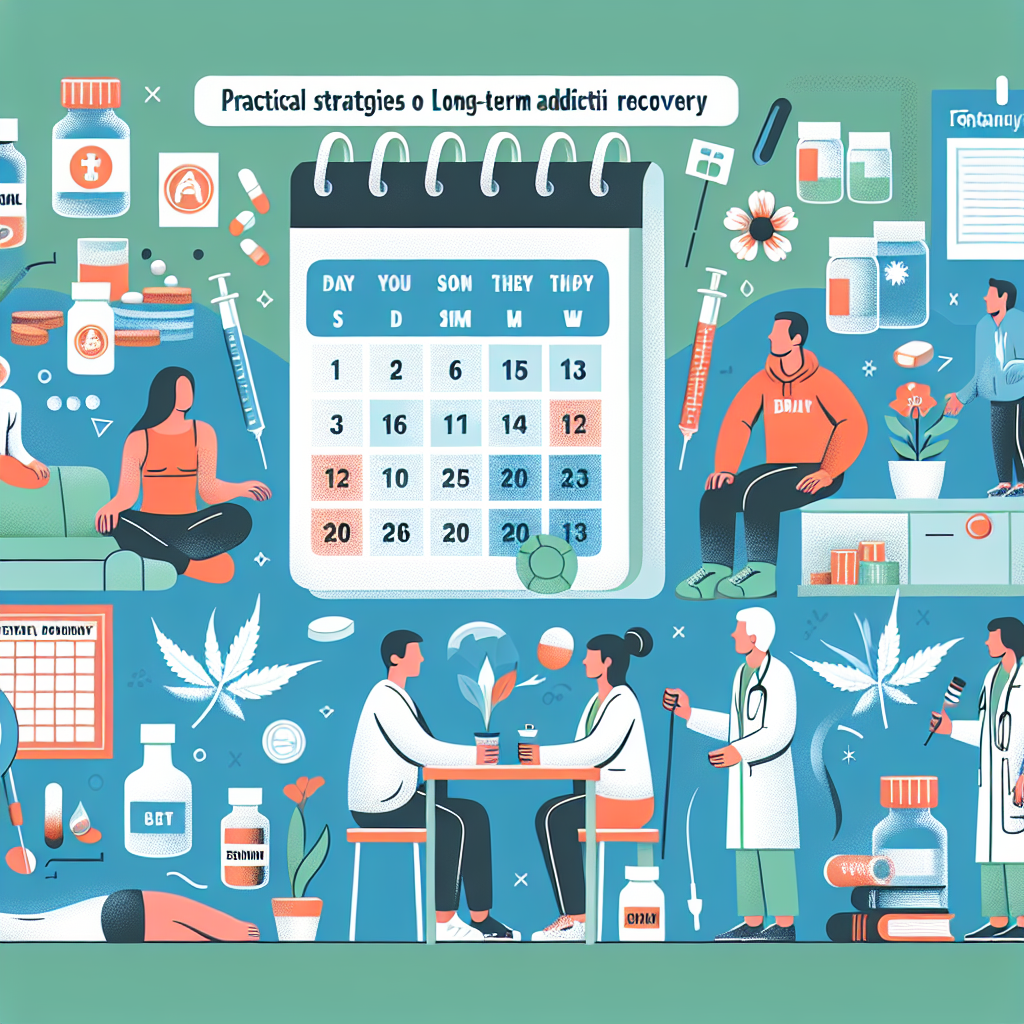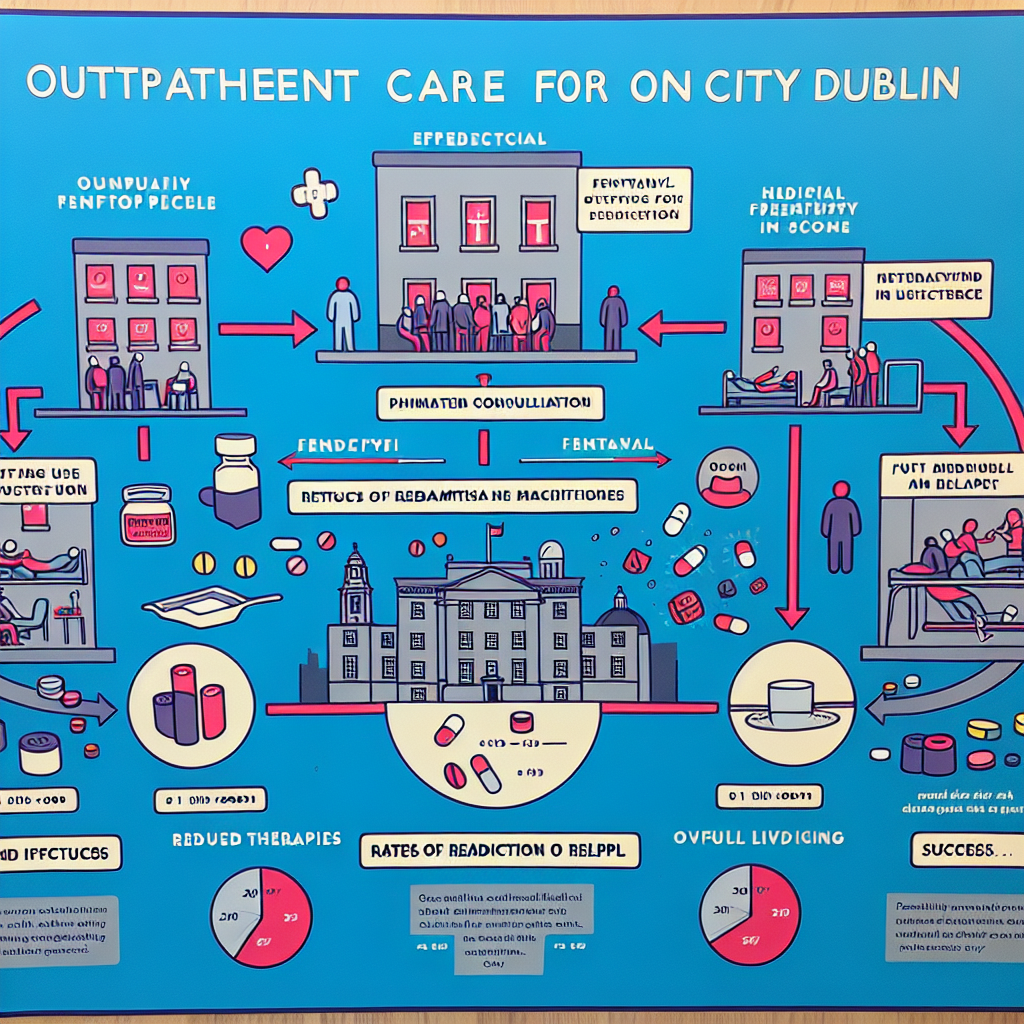-
Table of Contents
“Empower Your Future: Sustainable Solutions for Overcoming Fentanyl Addiction”
Introduction

Fentanyl addiction is a severe and complex condition that requires a comprehensive and sustained approach to recovery. Practical strategies for long-term fentanyl addiction recovery encompass a range of medical, psychological, and social interventions designed to support individuals in overcoming dependency and achieving lasting sobriety. These strategies include medically supervised detoxification, evidence-based behavioral therapies, medication-assisted treatment (MAT), and robust support systems such as peer support groups and family involvement. Additionally, addressing co-occurring mental health disorders, developing healthy coping mechanisms, and creating a structured and supportive environment are crucial components of a successful recovery plan. By integrating these multifaceted approaches, individuals can build a solid foundation for long-term recovery and improve their overall quality of life.
Developing a Personalized Recovery Plan
Developing a personalized recovery plan is a crucial step in achieving long-term recovery from fentanyl addiction. This process involves a comprehensive approach that addresses the unique needs and circumstances of each individual. By tailoring the recovery plan to fit personal goals, strengths, and challenges, individuals can enhance their chances of sustained sobriety and a healthier future.
The first step in creating a personalized recovery plan is to conduct a thorough assessment of the individual’s physical, emotional, and psychological state. This assessment should be carried out by healthcare professionals who specialize in addiction treatment. They can help identify underlying issues such as co-occurring mental health disorders, which often accompany substance use disorders. Understanding these factors is essential for developing an effective treatment strategy.
Once the assessment is complete, the next step is to set realistic and achievable goals. These goals should be specific, measurable, attainable, relevant, and time-bound (SMART). For instance, an individual might set a goal to attend a certain number of therapy sessions each week or to participate in a support group regularly. Setting clear goals provides a sense of direction and purpose, which can be incredibly motivating during the recovery journey.
Incorporating a variety of therapeutic approaches is another key aspect of a personalized recovery plan. Cognitive-behavioral therapy (CBT) is often highly effective in helping individuals understand and change the thought patterns that contribute to their addiction. Additionally, motivational interviewing can help individuals find the internal motivation needed to commit to recovery. Holistic therapies such as yoga, meditation, and art therapy can also play a significant role in promoting overall well-being and reducing stress.
Support systems are vital for long-term recovery. Building a strong network of supportive friends, family members, and peers can provide encouragement and accountability. Support groups, such as Narcotics Anonymous (NA), offer a sense of community and shared experience that can be incredibly comforting. These groups provide a safe space to share struggles and successes, fostering a sense of belonging and understanding.
Another important component of a personalized recovery plan is addressing lifestyle changes. Developing healthy habits, such as regular exercise, balanced nutrition, and adequate sleep, can significantly impact overall well-being and recovery success. Engaging in activities that bring joy and fulfillment can also help individuals find new passions and interests that replace the void left by substance use.
Medication-assisted treatment (MAT) may be an option for some individuals recovering from fentanyl addiction. Medications such as buprenorphine or methadone can help manage withdrawal symptoms and reduce cravings, making it easier to focus on other aspects of recovery. It is essential to work closely with healthcare providers to determine if MAT is appropriate and to monitor its effectiveness.
Finally, ongoing evaluation and adjustment of the recovery plan are crucial. Recovery is a dynamic process, and what works at one stage may need to be modified as progress is made. Regular check-ins with healthcare providers and therapists can help ensure that the plan remains relevant and effective. Being open to change and willing to adapt the plan as needed can help individuals stay on track and continue moving forward.
In conclusion, developing a personalized recovery plan for fentanyl addiction involves a multifaceted approach that addresses the unique needs of each individual. By setting realistic goals, incorporating various therapeutic approaches, building strong support systems, making healthy lifestyle changes, considering medication-assisted treatment, and regularly evaluating progress, individuals can create a solid foundation for long-term recovery. With determination, support, and a well-crafted plan, it is possible to overcome addiction and build a fulfilling, substance-free life.
Building a Strong Support Network
Building a strong support network is a cornerstone of long-term fentanyl addiction recovery. The journey to sobriety is often fraught with challenges, and having a reliable support system can make a significant difference in overcoming these obstacles. One of the first steps in establishing this network is to identify individuals who are genuinely invested in your well-being. These can include family members, close friends, and even colleagues who understand the gravity of your situation and are willing to offer their unwavering support.
In addition to personal connections, professional support is equally crucial. Engaging with healthcare providers, such as doctors and therapists who specialize in addiction recovery, can provide you with the medical and psychological assistance necessary to navigate the complexities of withdrawal and rehabilitation. These professionals can offer tailored treatment plans, prescribe appropriate medications, and provide counseling sessions that address the underlying issues contributing to your addiction.
Moreover, joining support groups can be incredibly beneficial. Groups like Narcotics Anonymous (NA) offer a sense of community and shared experience that can be profoundly comforting. In these settings, you can connect with others who are facing similar struggles, share your experiences, and gain insights from those who have successfully maintained their sobriety. The camaraderie and mutual encouragement found in these groups can be a powerful motivator to stay on the path to recovery.
Another practical strategy is to leverage technology to stay connected with your support network. In today’s digital age, there are numerous apps and online platforms designed to facilitate communication and provide resources for those in recovery. Virtual meetings, online forums, and mobile apps can offer immediate support and guidance, especially during moments of vulnerability when in-person interactions may not be possible.
Furthermore, it’s essential to set clear boundaries with individuals who may not be supportive of your recovery journey. This might involve distancing yourself from friends or acquaintances who engage in substance use or who do not respect your commitment to sobriety. Establishing these boundaries can help create a safer and more conducive environment for your recovery.
In addition to external support, cultivating self-compassion and resilience is vital. Recovery is a long-term process that requires patience and perseverance. There will be setbacks and moments of doubt, but it’s important to treat yourself with kindness and recognize your progress, no matter how small. Practicing mindfulness and stress-reduction techniques, such as meditation and yoga, can also enhance your emotional well-being and help you stay focused on your recovery goals.
Lastly, involving your support network in your recovery plan can foster a sense of accountability and shared responsibility. Regularly updating your loved ones on your progress, celebrating milestones together, and seeking their input on your recovery strategies can strengthen your commitment to sobriety. Their encouragement and belief in your ability to overcome addiction can serve as a powerful reminder of why you embarked on this journey in the first place.
In conclusion, building a strong support network is an indispensable part of long-term fentanyl addiction recovery. By surrounding yourself with caring individuals, seeking professional help, participating in support groups, utilizing technology, setting boundaries, practicing self-compassion, and involving your network in your recovery plan, you can create a robust foundation for lasting sobriety. Remember, recovery is not a solitary endeavor; it is a collective effort that thrives on the strength and support of those who care about you.
Incorporating Holistic Therapies in Recovery
Incorporating holistic therapies into long-term fentanyl addiction recovery can be a transformative approach that addresses the multifaceted nature of addiction. While traditional methods such as medication-assisted treatment and counseling are crucial, holistic therapies offer complementary benefits that can enhance overall well-being and support sustained recovery. By integrating these therapies, individuals can find balance and healing in mind, body, and spirit, which is essential for long-term success.
One of the primary benefits of holistic therapies is their ability to reduce stress and promote relaxation. Practices such as yoga and meditation have been shown to lower cortisol levels, which can help mitigate the anxiety and stress often associated with addiction recovery. These practices encourage mindfulness, allowing individuals to become more aware of their thoughts and emotions without judgment. This heightened awareness can be particularly beneficial in recognizing and managing triggers, ultimately reducing the risk of relapse.
In addition to stress reduction, holistic therapies can also improve physical health, which is often compromised during addiction. Nutritional counseling, for example, can help individuals restore their bodies by focusing on a balanced diet rich in essential nutrients. Proper nutrition can enhance energy levels, improve mood, and support the body’s natural detoxification processes. Similarly, regular physical activity, whether through structured exercise programs or activities like tai chi, can boost endorphin levels, improve cardiovascular health, and foster a sense of accomplishment and well-being.
Moreover, holistic therapies can address the emotional and psychological aspects of recovery. Art therapy and music therapy provide creative outlets for expressing emotions that may be difficult to articulate through words alone. These therapies can help individuals process trauma, build self-esteem, and develop healthier coping mechanisms. Engaging in creative activities can also offer a sense of purpose and fulfillment, which is vital for maintaining motivation in recovery.
Another significant aspect of holistic therapies is their focus on spiritual well-being. Practices such as mindfulness meditation, prayer, or participation in spiritual communities can provide a sense of connection and purpose. Spirituality, in this context, does not necessarily refer to religious beliefs but rather to a sense of belonging and meaning in life. This spiritual connection can be a powerful source of strength and resilience, helping individuals navigate the challenges of recovery with a renewed sense of hope and determination.
Furthermore, incorporating holistic therapies into a comprehensive recovery plan can foster a sense of community and support. Group activities such as group meditation sessions, yoga classes, or support groups centered around holistic practices can create a network of like-minded individuals who share similar goals and experiences. This sense of community can alleviate feelings of isolation and provide a supportive environment where individuals can share their struggles and successes.
In conclusion, incorporating holistic therapies into long-term fentanyl addiction recovery offers a well-rounded approach that addresses the physical, emotional, and spiritual dimensions of healing. By reducing stress, improving physical health, fostering emotional expression, and enhancing spiritual well-being, these therapies can significantly contribute to sustained recovery. Embracing a holistic approach not only supports individuals in overcoming addiction but also empowers them to lead healthier, more fulfilling lives. As we continue to explore and integrate these therapies, we can offer more comprehensive and effective support for those on the path to recovery.
Utilizing Technology for Ongoing Support
In the journey toward long-term recovery from fentanyl addiction, utilizing technology for ongoing support can be a game-changer. The digital age has ushered in a plethora of tools and resources that can provide continuous assistance, making the path to sobriety more manageable and less isolating. By integrating these technological advancements into a comprehensive recovery plan, individuals can find the support they need to maintain their commitment to a drug-free life.
One of the most significant benefits of technology in addiction recovery is the accessibility of online support groups. These virtual communities offer a safe space for individuals to share their experiences, challenges, and triumphs with others who understand their struggles. Platforms like Reddit, Facebook, and specialized recovery forums provide 24/7 access to peer support, which can be particularly valuable during moments of vulnerability. The sense of belonging and understanding that comes from these online interactions can be a powerful motivator, helping individuals stay focused on their recovery goals.
In addition to online support groups, mobile applications designed for addiction recovery can be incredibly beneficial. Apps like Sober Grid, WEconnect, and Recovery Path offer features such as daily check-ins, mood tracking, and goal setting. These tools can help individuals monitor their progress, identify triggers, and develop coping strategies. Moreover, many of these apps include built-in emergency support features, such as the ability to connect with a sponsor or a crisis hotline, providing immediate assistance when needed.
Telehealth services have also revolutionized the way individuals can access professional help. Virtual therapy sessions with licensed counselors and addiction specialists offer the convenience of receiving expert guidance from the comfort of one’s home. This can be particularly advantageous for those who may have difficulty attending in-person sessions due to geographical, financial, or time constraints. Telehealth not only makes therapy more accessible but also allows for more frequent and flexible appointments, ensuring that individuals receive the consistent support they need.
Furthermore, technology can play a crucial role in education and self-awareness. Online courses, webinars, and informational websites provide a wealth of knowledge about addiction, recovery strategies, and mental health. By staying informed, individuals can better understand their condition and the various methods available to support their recovery. Knowledge is empowering, and being well-informed can help individuals make more effective decisions about their treatment and lifestyle choices.
Another innovative use of technology in addiction recovery is the implementation of wearable devices. Fitness trackers and smartwatches can monitor physical health indicators such as heart rate, sleep patterns, and activity levels. These devices can help individuals maintain a healthy lifestyle, which is a critical component of recovery. Regular physical activity, adequate sleep, and proper nutrition can significantly improve mental health and reduce the risk of relapse. By providing real-time data and feedback, wearable technology can encourage individuals to stay on track with their wellness goals.
Lastly, social media can be a double-edged sword in the context of addiction recovery. While it can offer support and inspiration, it can also expose individuals to triggers and negative influences. Therefore, it is essential to curate a positive and supportive online environment. Following recovery-focused accounts, joining positive communities, and unfollowing or blocking harmful content can create a digital space that reinforces sobriety and well-being.
In conclusion, leveraging technology for ongoing support in fentanyl addiction recovery offers numerous advantages. From online support groups and mobile apps to telehealth services and wearable devices, these tools can provide continuous assistance, education, and motivation. By embracing these technological resources, individuals can enhance their recovery journey, making it more sustainable and less isolating. The path to long-term sobriety is challenging, but with the right support and tools, it is undoubtedly achievable.
Q&A
1. **Question:** What is a key component of a comprehensive treatment plan for long-term fentanyl addiction recovery?
**Answer:** A key component is Medication-Assisted Treatment (MAT), which often includes medications like methadone, buprenorphine, or naltrexone to manage withdrawal symptoms and cravings.
2. **Question:** How important is behavioral therapy in the recovery process from fentanyl addiction?
**Answer:** Behavioral therapy is crucial as it helps individuals modify their attitudes and behaviors related to drug use, enhances life skills, and supports other treatment components.
3. **Question:** What role does a support network play in long-term recovery from fentanyl addiction?
**Answer:** A strong support network, including family, friends, and support groups, provides emotional support, accountability, and encouragement, which are vital for sustained recovery.
4. **Question:** Why is it important to address co-occurring mental health disorders in fentanyl addiction recovery?
**Answer:** Addressing co-occurring mental health disorders is important because untreated mental health issues can trigger relapse and hinder the recovery process. Integrated treatment approaches that address both addiction and mental health are more effective.
Conclusion
In conclusion, practical strategies for long-term fentanyl addiction recovery include a comprehensive approach that integrates medical treatment, such as medication-assisted therapy (MAT) with drugs like methadone or buprenorphine, with behavioral therapies and counseling. Support systems, including peer support groups and family involvement, play a crucial role in maintaining sobriety. Additionally, addressing co-occurring mental health disorders, developing healthy lifestyle habits, and creating a structured, supportive environment are essential components. Continuous monitoring and adjustments to the recovery plan ensure that individuals can effectively manage triggers and prevent relapse, ultimately leading to sustained recovery and improved quality of life.



